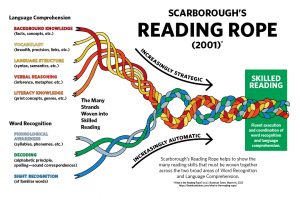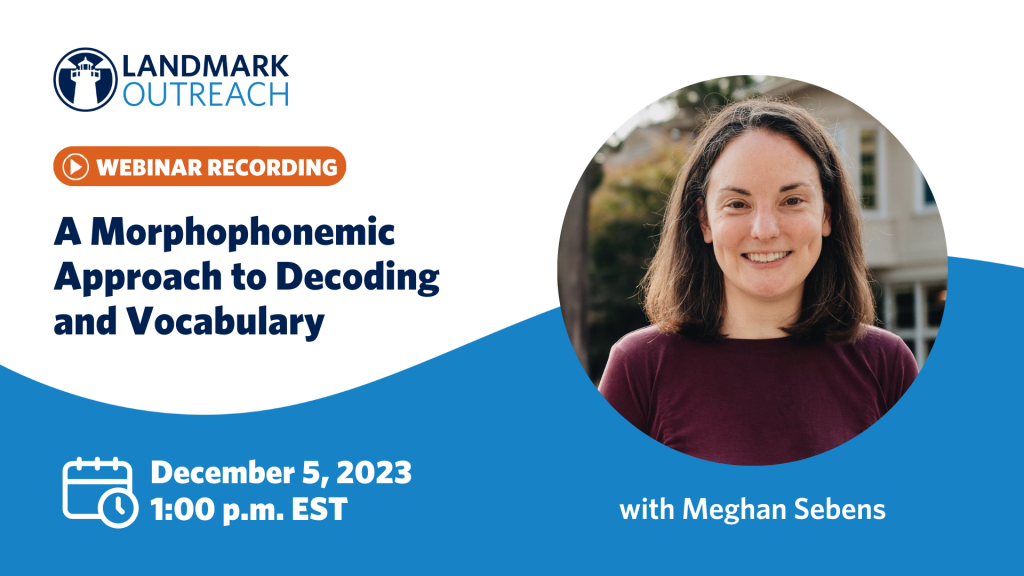Definitions
- The Alphabetic Principle is the understanding that sounds in words are represented by letters.
- Phonics is the ability to connect sounds to letters and letter combinations.
- Decoding is “the blending of letter sounds to generate pronunciations of written words” (O’Connor, 2014, p. 9).
- Word Study refers to routines that encourage students to examine, discriminate, and make critical judgments about speech sounds, spelling patterns, and meanings (Bear, 2016, p. 4).
Word Recognition
Word recognition is essential to proficient reading. Scarborough’s Reading Rope model asserts that to achieve skilled reading, word recognition is equally as important as language comprehension (Scarborough, 2001, p. 98). Noted literacy expert Louise Spear-Swerling describes the development of word recognition as the process of intertwining phonological and phonemic awareness and letter-sound knowledge in order to read words (Spear-Swerling, 2022, p. 26). Scarborough’s Reading Rope model reinforces this definition and depicts word recognition as three interrelated skills: phonological awareness, decoding, and sight recognition (Scarborough, 2001, p. 98). Ultimately, these three strands of Scarborough’s Reading Rope weave together to enable readers to recognize words instantly.

Decoding Building Blocks
Reading researcher Dr. Rollanda E. O’Connor (2014) defines decoding as “the blending of letter sounds to generate pronunciations of written words” (p. 9). Whereas phonemic awareness allows students to manipulate speech sounds, and phonics allows students to associate speech sounds with letters, decoding allows students to connect sound-symbol relationships to read words. It is important to know that decoding requires conscious effort as students apply their skills to problem-solving unfamiliar words. This is not the same as automatic word recognition, which is an instant, unconscious ability to know what a word says. However, strong decoding skills are a necessary prerequisite for building automatic word recognition.
There are many literacy skills required for students to be able to decode the words they encounter.
Phonemic Awareness
First, students must possess phonemic awareness— the ability to hear, identify, and manipulate phonemes (smallest unit of sound) in spoken words. Without an understanding that our speech is broken down into distinct sounds, the next step of attaching letters or letter combinations to those sounds will be challenging (O’Connor, 2014, p. 27).
Phonics
The first step of learning phonics involves learning the alphabetic principle, which is the idea that phonemes (sounds) are connected to graphemes (letters). “When students understand how to read and write words reciprocally to turn speech into printed words and printed words back into speech (the alphabetic principles), they are ready to learn how to decode the words that they see” (O’Connor, 2014, p. 54).
The study of phonics helps students solidify their understanding of the alphabetic principle. Phonics refers to “knowledge of letter-sound (grapheme-phoneme) correspondences in English and the ability to apply this knowledge” when reading words (Spear-Swerling, 2022, p. 2).
Like all vetted reading instructional strategies, phonics should be taught explicitly and systematically. Students should be exposed to and taught specific patterns such as digraphs (e.g., ch, sh, tch), vowel teams (e.g., ee, ai, oa), r-controlled vowels (e.g., or, ar, er), and soft c (i.e., cent, city, cycle). When students apply their growing knowledge of phonics to read words, they are decoding.
Word Study
As students become more proficient in their ability to decode words; engaging them in word study can help facilitate their understanding of how to decode longer, multisyllabic words. Word study involves routines that require students to examine, discriminate, and make critical judgments about speech sounds, spelling patterns, and meanings (Bear, 2016, p. 4).
Word study is particularly helpful for struggling older readers, and there are a variety of instructional approaches. A common word study focus involves direct instruction in recognizing and understanding affixes which allows students to transfer their knowledge of known patterns to the decoding of unknown words. For example, teaching common prefixes, suffixes, and their meanings, such as pre- (“before” as in pretest, preview) or -ing (“present tense” as in crashing, locking), can support students in more accurately decoding unfamiliar multisyllabic words. Moreover, research shows that it is most beneficial to teach affixes in context, pairing instruction with example sentences instead of only reviewing definitions (Spear-Swerling, 2022, p. 57).
Decoding Difficulties
For students who struggle with reading, a frequent characteristic of their difficulties is their ability to decode words. Many literacy experts note that decoding instruction is a non-negotiable aspect of any reading program. When students struggle with decoding they also often struggle with fluency and comprehension, and, in turn, this causes feelings of frustration and failure. When a student feels frustrated and overwhelmed by reading, that student will read less, decreasing essential exposure to background knowledge and vocabulary. Access to scientifically validated reading instruction, which includes instruction in decoding, has been characterized as a right for all students, but is particularly necessary for students with demonstrated learning differences. Thus, it is imperative that students who struggle to decode receive instruction in phonemic awareness, phonics, and word study.
References
Bear, Donald R., et al. (2016). Words Their Way: Word Study for Phonics, Vocabulary, and Spelling Instruction. Pearson: Boston.
Gough, P.B. & Tunmer, W.E. (1986). Decoding, reading, and reading disability. Remedial and Special Education, 7, 6–10.
Hoover, W.A. & Gough, P.B. (1990). The simple view of reading. Reading and Writing, 2(2), 127-160.
O’Connor, R. E. (2014). Teaching word recognition: Effective strategies for students with learning difficulties (2nd ed.). Guilford Press.
Scarborough, H.S. (2001). Connecting early language and literacy to later reading (dis)abilities: Evidence, Theory, and Practice. In S. Neuman & D. Dickinson (Eds.), Handbook for research in early literacy (pp. 97-110). Guilford Press.\
Spear-Swerling, L. (Ed.). (2022). Structured literacy interventions: Teaching students with reading difficulties, grades K-6. The Guilford Press.

